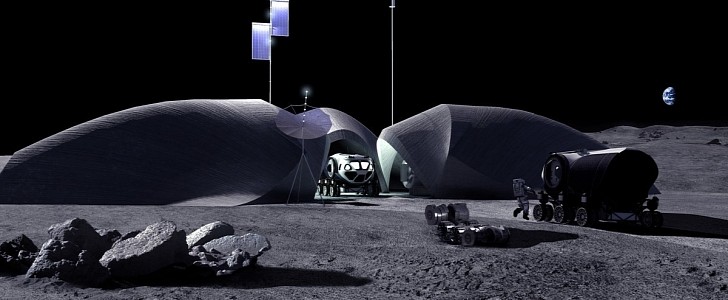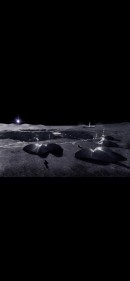Several companies are working on developing innovative technologies that will allow humanity to return to the Moon and establish a long-term presence on its surface. One of them is LINA, a robust 3D-printed lunar outpost designed to blend with the lunar landscape.
By the end of the decade, NASA plans to return humanity to the Moon as part of the Artemis program. In order to sustain long-term missions on the satellite's surface, the agency will need a Moon base capable of facing the challenges posed by the harsh lunar environment.
Space technology company AI SpaceFactory revealed the design for LINA, a lunar outpost developed in collaboration with engineers from NASA Kennedy Space Center. Back in 2018, AI SpaceFactory showed the prototype of a 3D-printed Martian habitat. This time, it wanted to push the limits of what its 3D-printing technology could do.
The recently-unveiled Moon base is part of NASA's 2020 Announcement of Collaboration Opportunity (ACO) project. The initial polymer created by AI SpaceFactory using a Martian regolith simulant was changed to utilize lunar regolith or lunar soil. The results will be evaluated in a NASA vacuum chamber that simulates the harsh lunar environment and will contribute to the development of a long-lasting 3D printing technology that will lead to the production of many structures on the Moon.
The company hopes that one of them will be LINA, an innovative lunar outpost that can seamlessly blend into the lunar terrain. LINA's main purpose is to keep astronauts safe during the cold lunar nights and against cosmic radiation, moonquakes, micrometeoroid impacts, and contamination from lunar dust.
LINA can be expanded from a single structure to multiple units, contrary to the company's previous Mars habitat, which was created as a free-standing item. Therefore, it will also be capable of hosting manned rovers and different scientific payloads.
It will integrate a photovoltaic tree that will harvest sunlight. Each unit will offer around 75 sq meters (807 sq ft) of space and a total height of five meters (16.4 ft). To provide the highest level of protection, the 3D-printed structure's arches would be covered with 2.7 meters (8.8 ft) of lunar regolith.
According to AI SpaceFactory, autonomous robots will build LINA on the Moon's South Pole, near the Shackleton crater. That will allow the sunlight on the crater's peaks to provide solar power.
Space technology company AI SpaceFactory revealed the design for LINA, a lunar outpost developed in collaboration with engineers from NASA Kennedy Space Center. Back in 2018, AI SpaceFactory showed the prototype of a 3D-printed Martian habitat. This time, it wanted to push the limits of what its 3D-printing technology could do.
The recently-unveiled Moon base is part of NASA's 2020 Announcement of Collaboration Opportunity (ACO) project. The initial polymer created by AI SpaceFactory using a Martian regolith simulant was changed to utilize lunar regolith or lunar soil. The results will be evaluated in a NASA vacuum chamber that simulates the harsh lunar environment and will contribute to the development of a long-lasting 3D printing technology that will lead to the production of many structures on the Moon.
The company hopes that one of them will be LINA, an innovative lunar outpost that can seamlessly blend into the lunar terrain. LINA's main purpose is to keep astronauts safe during the cold lunar nights and against cosmic radiation, moonquakes, micrometeoroid impacts, and contamination from lunar dust.
LINA can be expanded from a single structure to multiple units, contrary to the company's previous Mars habitat, which was created as a free-standing item. Therefore, it will also be capable of hosting manned rovers and different scientific payloads.
It will integrate a photovoltaic tree that will harvest sunlight. Each unit will offer around 75 sq meters (807 sq ft) of space and a total height of five meters (16.4 ft). To provide the highest level of protection, the 3D-printed structure's arches would be covered with 2.7 meters (8.8 ft) of lunar regolith.
According to AI SpaceFactory, autonomous robots will build LINA on the Moon's South Pole, near the Shackleton crater. That will allow the sunlight on the crater's peaks to provide solar power.




